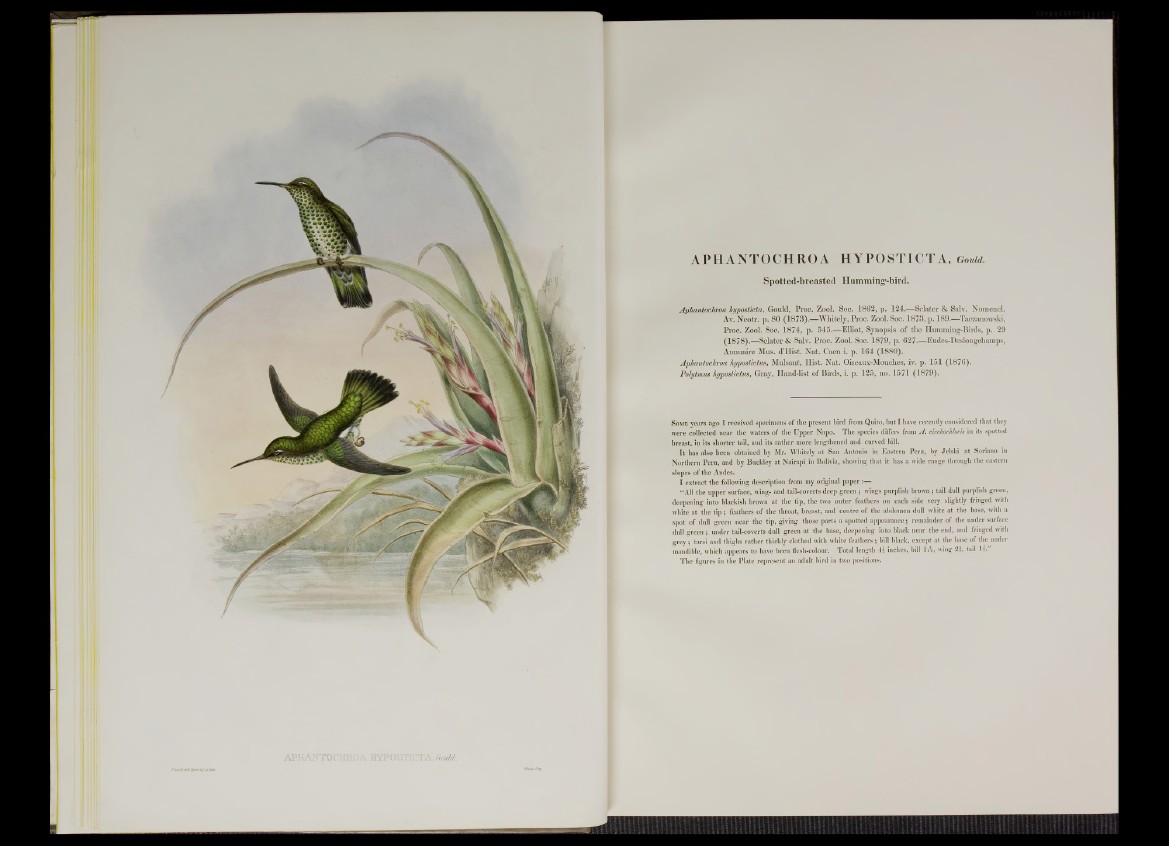
APHANTOCMROA HYPOSTICTA, 6mM.
APHANTOCHROA HYPOSTICTA, Gould.
Spotted-breasted Humming’-bird.
Aphantochroa hyposticta, Gould, Proc. Zool. Soc. 1 8 6 2 , p. 1 24.— Sclater & Salv. Nomencl.
Av. N eotr. p. 8 0 (1 8 7 3 ).— Whitely, Proc. Zool. Soc. 1 8 7 3 , p . 1 89.— Taczanowski,
Proc. Zool. Soc. 1 8 7 4 , p. 5 4 5 .— Elliot, Synopsis o f the Humming-Birds, p. 29
(1 8 7 8 ) .— Sclater & Salv. Proc. Zool. Soc. 1 8 7 9 , p. 6 2 7 .— Eudes-Deslongchamps,
Annuaire Mus. d’H ist. N a t. Caen i. p. 16 4 (1 8 8 0 ).
Aphantochroa hypostictus, Mulsant, H ist. N a t. Oiseaux-Mouches, iv. p. 151 (1 8 7 6 ).
Polytmus hypostictus, Gray, Hand-list o f Birds, i. p. 1 25, no. 157 1 (1 8 7 9 ).
Some years ago I received specimens o f the present bird from Quito, but I have recently considered that they
were collected near the waters o f the Upper Napo. The species differs from A. cirrhochloris in its spotted
breast, in its shorter tail, and its rather more lengthened and curved bill.
It has also been obtained by Mr. Whitely at San Antonio in Eastern Peru, by Jelski at Soriano in
Northern Peru, and by Buckley at Nairapi in Bolivia, showing that it has a wide range through the eastern
slopes o f the Andes.
I extract the following description from my original paper :—■
“All the upper surface, wing- and tail-coverts deep green ; wings purplish brown; tail dull purplish green,
deepening into blackish brown at the tip, the two outer feathers on each side very slightly fringed with
white at the tip ; feathers o f the throat, breast, and centre of the abdomen dull white at the base, with a
spot o f dull green near the tip, giving those parts a spotted appearance 5 remainder of the under surface
dull green ; under tail-coverts dull green at the base, deepening into black near the end, and fringed with
grey ; tarsi and thighs rather thickly clothed with white feathers ; bill black, except at the base of the under
mandible, which appears to have been flesh-colour. Total length 4 i inches, bill 1 A , wing 2 |, tail l i.
The figures in the Plate represent an adult bird in two positions.